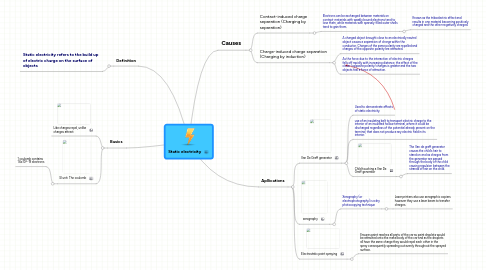
1. Definition
1.1. Static electricity refers to the build up of electric charge on the surface of objects
2. Causes
2.1. Contact-induced charge separation (Charging by separation)
2.1.1. Electrons can be exchanged between materials on contact; materials with weakly bound electrons tend to lose them, while materials with sparsely filled outer shells tend to gain them.
2.1.1.1. Known as the triboelectric effect and results in one material becoming positively charged and the other negatively charged.
2.2. Charge-induced charge separation (Charging by induction)
2.2.1. A charged object brought close to an electrically neutral object causes a separation of charge within the conductor. Charges of the same polarity are repelled and charges of the opposite polarity are attracted.
2.2.2. As the force due to the interaction of electric charges falls off rapidly with increasing distance, the effect of the closer (opposite polarity) charges is greater and the two objects feel a force of attraction.
3. Apllications
3.1. Van De Graff generator
3.1.1. Used to demonstrate effects of static electricity.
3.1.2. use of an insulating belt to transport electric charge to the interior of an insulated hollow terminal, where it could be discharged regardless of the potential already present on the terminal, that does not produce any electric field in its interior.
3.1.3. Child touching a Van De Graff generator
3.1.3.1. The Van de graff generator causes the child's hair to stand on end as charges from the generator are passed through the body of the child causing repulsion between the strands of hair on the child.
3.2. xerography
3.2.1. Xerography (or electrophotography) is a dry photocopying technique
3.2.1.1. Laser printers also use xerographic copiers however they use a laser beam to transfer charges.
3.3. Electrostatic paint spraying
3.3.1. Ensures paint reaches all parts of the car as paint droplets would be attracted onto the metal body of the car and as the droplets all have the same charge they would repel each other in the spray consequently spreading out evenly throughout the sprayed surface.
4. Basics
4.1. Like charges repel, unlike charges attract
4.2. SI unit: The coulomb
4.2.1. 1 coulomb contains 1.6x10^-19 electrons

